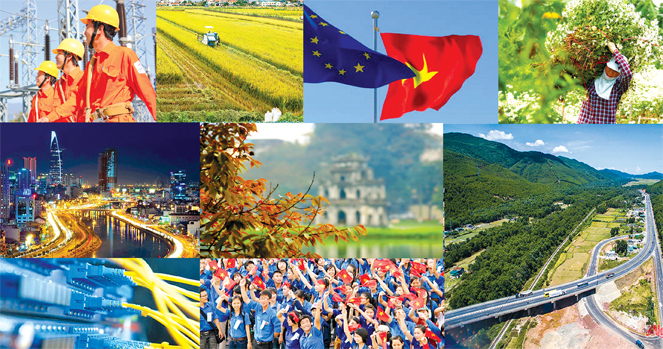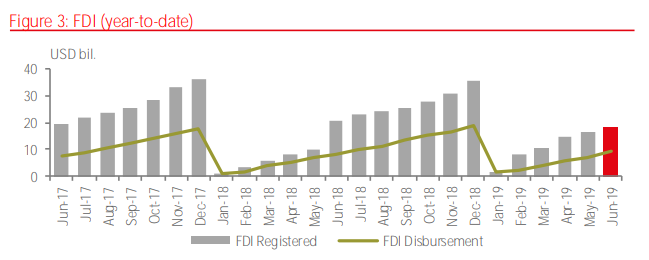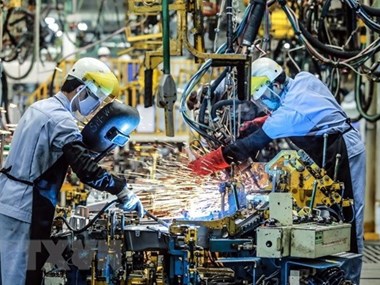Vietnam’s economy stayed strong in the first half (H1) of this year with robust retail turnover, record import-export turnover, high foreign direct investment (FDI), stable consumer price index (CPI), growing international arrivals, and a surge in newly-established enterprises.

|
JLL – services firm that specializes in real estate and investment management – provides an overview of Vietnam’s economy through following highlights.
GDP growth on track Vietnam’s economy maintained stable growth with 6.76% in H1, a little bit hurt from abnormal movements of the livestock industry caused by African swine fever virus which spread nationwide.
Within the general growth, the industrial and construction sector posted an increase of 9.14%, the highest rate amongst sectors, the General Statistics Office (GSO) reported.
Meanwhile, services and agro-forestry-fisheries sectors grew by 6.85% and 2.19%, respectively during the first half.
The whole year’s growth target of 6.6%-6.9% is likely achievable thanks to manufacturing and processing sector as they maintain a relatively high level, JLL predicted.
 Vietnam's GDP growth rate in H1. Photo: JLL/GSO |
Recorded import-export turnover
The import-export turnover of US$245.48 billion in H1 has been the largest six-month value ever, with a trade deficit of US$34 million between January and June.
The US and EU remained the two largest export markets of Vietnam, contributing US$27.5 billion and US$20.6 billion, respectively to the Southeast Asian country’s total exports in the six-month period, with key products namely phones and devices, electronic appliances, garment and textile products.
Meanwhile, China and South Korea continued to be the biggest importers with US$36.8 billion and US$22.9 billion, respectively, with metals, garments, machinery, electronic equipment, computers and mobiles.
Rising retail sales, international arrivals
In H1, the total sales of consumer goods and services rose 11.5% compared to the previous year.
While the total number of foreign tourist arrivals reached 8.48 million, up 7.5% on year, as Vietnam remained a favorable destination, according to the Vietnam National Administration of Tourism.
Visitors from Asia still made up the biggest proportion, of which Chinese, South Korean, and Japanese took the lead amongst visitors coming to Vietnam.
Strong FDI inflows
 FDP commitments in Vietnam in H1. Photo: JLL/GSO |
FDI commitments to the country totaled nearly US$18.47 billion in H1, demonstrating a surge of 90.8% from the same period last year.
As much as 1,723 newly-registered projects worth US$7.41 billion were reported during the period, increasing 62.8% on year.
FDI disbursement was recorded at US$9.1 billion, representing an increase of nearly 8% on year.
Among 19 investment industries, processing and manufacturing was the most attractive sector, recording US$13.15 billion, equivalent to 71.2% of the total capital, followed by real estate sector with US$1.32 billion and trade and services with US$1.05 billion.
Hong Kong (China) took the lead among 95 countries investing in Vietnam in H1 with a total of US$5.3 billion, accounting for 28.7% of the total FDI during the period. It is followed by South Korea with US$2.73 billion and China with US$2.2 billion.
Stable CPI
 CPI in Vietnam in H1. Photo: JLL/GSO |
CPI increased approximately 2.64% in H1, representing the lowest 6-month average increase in the last three years.
The price hike was mainly owing to: (1) demand for food and foodstuff rose 5.4%, of which pork meat increased 14.85%; (2) the price of construction materials increased by 1.99%; (3) stationery price for 2019-2020 school year increased by 2.57%, and (4) the price for electricity up 5.84% compared to same period last year.
CPI for the remaining two quarters of 2019 is projected to go within the National Assembly’s target of around 4%.
Soaring newly-established enterprises
Roughly 67,000 enterprises were newly set up in H1. The registered capital hit a new level at VND12.8 billion per newly-established enterprise each, up 27.7% on year.
The number of newly set up firms in real estate sector was 4,000, up 22.2% on year and accounting for 6% of the total newly-registered enterprises. Hanoitimes
Linh Pham

How should Vietnam develop its night-time economy?
Economists and businesses all believe that developing the night-time economy will bring new opportunities to Vietnam.

IMF forecasts Vietnam’s economy to grow by 6.5 percent in 2019
The International Monetary Fund (IMF) on July 16 said Vietnam’s economic growth is projected to slow to 6.5 percent in 2019 from a 10-year high of 7.1 percent in 2018, reflecting weakening external conditions.
 Vietnam`s economy kept growing track in the first half this year with maintained GDP growth rate and stable CPI.
Vietnam`s economy kept growing track in the first half this year with maintained GDP growth rate and stable CPI.